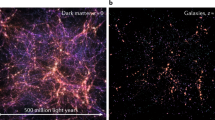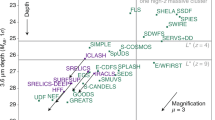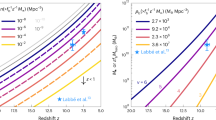Abstract
The past 20 years have seen dramatic advances in cosmology, mostly driven by observations from new telescopes and detectors. These instruments have allowed astronomers to map out the large-scale structure of the Universe and probe the very early stages of its evolution. We seem to have established the basic parameters describing the behaviour of our expanding Universe, thereby putting cosmology on a firm empirical footing. But the emerging ‘standard’ model leaves many details of galaxy formation still to be worked out, and new ideas are emerging that challenge the theoretical framework on which the structure of the Big Bang is based. There is still a great deal left to explore in cosmology.
This is a preview of subscription content, access via your institution
Access options
Subscribe to this journal
Receive 51 print issues and online access
$199.00 per year
only $3.90 per issue
Buy this article
- Purchase on Springer Link
- Instant access to full article PDF
Prices may be subject to local taxes which are calculated during checkout




Similar content being viewed by others
References
Einstein, A. The gravitational field equations [in German]. Sitz. Ber. Preuss. Akad. Wiss. 844–847 (1915).
Friedmann, A. On the curvature of space [in German]. Z. Phys. 10, 377–386 (1922).
Lemaitre, G. A homogenous universe of constant mass and increasing radius accounting for the radial velocity of the extragalactic nebulae. Ann. Soc. Sci. Brux. A 47, 49–59 (1929); [in English] Mon. Not. R. Astron. Soc. 91, 483–490 (1931).
Hubble, E. A relation between distance and radial velocity among extragalactic nebulae. Proc. Natl Acad. Sci. 15, 168–173 (1929).
Penzias, A. A. & Wilson, R. W. Measurement of excess antenna temperature at 4080 MHz. Astrophys. J. 142, 419–421 (1965).
Dicke, R. H., Peebles, P. J. E., Roll, P. G. & Wilkinson, D. T. Cosmic blackbody radiation. Astrophys. J. 142, 414–419 (1965).
Mather, J. C. et al. Measurement of the cosmic background spectrum by the COBE FIRAS instrument. Astrophys. J. 420, 439–444 (1994).
Gamow, G. Expanding universe and the origin of elements. Phys. Rev. 70, 572–573 (1946).
Alpher, R. A. & Herman, R. C. Evolution of the universe. Phys. Rev. 73, 803–804 (1948).
Guth, A. H. Inflationary Universe: A possible solution to the horizon and flatness problems. Phys. Rev. D 23, 347–356 (1981).
Albrecht, A. & Steinhardt, P. J. Cosmology for grand unified theories with radiatively induced symmetry breaking. Phys. Rev. Lett. 48, 1220–1223 (1982).
Linde, A. D. A new inflationary universe scenario: A possible solution of the horizon, flatness, homogeneity, isotropy and primordial monopole problems. Phys. Lett. B 108, 389–393 (1982).
Linde, A. D. Chaotic inflation. Phys. Lett. B 129, 177–181 (1983).
Kaluza, T. On the unification problem of physics [in German]. Sitz. Ber. Preuss. Akad. Wiss. 966–972 (1921).
Klein, O. Quantum theory and five-dimensional relativity theory [in German]. Z. Phys. 37, 895–906 (1926).
Khoury, J., Ovrut, B. A., Steinhardt, P. J. & Turok, N. Ekpyrotic universe: Colliding branes and the origin of the hot big bang. Phys. Rev. D 64, 13522 (2001).
Khoury, J., Ovrut, B. A., Steinhardt, P. J. & Turok, N. From big crunch to big bang. Phys. Rev. D 65, 086007 (2002).
Randall, L. & Sundrum, R. An alternative to compactification. Phys. Rev. Lett. 83, 4690–4693 (1999).
Jeans, J. H. The stability of spiral nebulae. Phil. Trans. R. Soc. Lond. A 199, 1–53 (1902).
Lifshitz, E. M. On the gravitational instability of the expanding universe. Sov. Phys. JETP 10, 116–122 (1946).
Linde, A. D. Scalar field fluctuations in the expanding universe and the new inflationary universe scenario. Phys. Lett. B 116, 335–339 (1982).
Guth, A. H. & Pi, S. -Y. Fluctuations in the new inflationary universe. Phys. Rev. Lett. 49, 1110–1113 (1982).
Starobinsky, A. A. Spectrum of relict gravitational radiation and the early state of the universe. Sov. Phys. JETP Lett. 30, 682–685 (1979).
Coles, P. & Ellis, G. F. R. The case for an open universe. Nature 370, 609–615 (1994).
Efstathiou, G., Sutherland, W. J. & Maddox, S. J. The cosmological constant and cold dark matter. Nature 348, 705–706 (1990).
Perlmutter, S. et al. Measurements of omega and lambda from 42 high-redshift supernovae. Astrophys. J. 517, 565–586 (1999).
Riess, A. G. et al. Observational evidence from supernovae for an accelerating universe and a cosmological constant. Astron. J. 116, 1009–1038 (1998).
Riess, A. G. et al. The farthest known supernova: Support for an accelerating universe and a glimpse of the epoch of deceleration. Astrophys. J. 560, 49–71 (2001).
Tonry, J. L. et al. Cosmological results from high-z supernovae. Astrophys. J. 594, 1–24 (2003).
Freedman, W. L. et al. Final results from the Hubble Space Telescope key project to measure the Hubble constant. Astrophys. J. 553, 47–72 (2001).
Carretta, E., Gratton, R. G., Clementini, G. & Flavio, F. P. Distances, ages and epoch of formation of globular clusters. Astrophys. J. 533, 215–235 (2000).
Casimir, H. B. G. On the attraction between two perfectly conducting plates. Proc. K. Ned. Akad. Wet. 51, 793–795 (1948).
Weinberg, S. The cosmological constant problem. Rev. Mod. Phys. 6, 1–22 (1989).
Wang, L., Caldwell, R. R., Ostriker, J. P. & Steinhard, P. J. Cosmic concordance and quintessence. Astrophys. J. 530, 17–35 (2000).
Sahni, V. The cosmological constant problem and quintessence. Class. Quant. Grav. 19, 3435–3448 (2002).
Peebles, P. J. E. & Ratra, B. The cosmological constant and dark energy. Rev. Mod. Phys. 75, 559–606 (2003).
Bennett, C. L. et al. First-year Wilkinson Microwave Anisotropy Probe (WMAP) observations. Astrophys. J. Suppl. 148, 1–27 (2003).
Hinshaw, G. et al. First-year Wilkinson Microwave Anisotropy Probe (WMAP) observations: The angular power spectrum. Astrophys. J. Suppl. 148, 135–159 (2003).
Smoot, G. F. et al. Structure in the COBE differential microwave radiometer first year maps. Astrophys. J. 396, L1–L4 (1992).
de Bernardis, P. et al. A flat universe from high-resolution maps of the cosmic microwave background radiation. Nature 420, 763–765 (2000).
Lange, A. E. et al. Cosmological parameters from the first results of BOOMERANG. Phys. Rev. D. 63, 042001 (2001).
Hanany, S. et al. MAXIMA-1: A measurement of the cosmic microwave background anisotropy on angular scales 10 arc minutes to 5 degrees. Astrophys. J. 545, L5–L9 (2000).
Balbi, A. et al. Constraints on cosmological parameters from MAXIMA-1 Astrophys. J. 545, L1–L4 (2000).
Lee, A. et al. A high spatial resolution analysis of the MAXIMA-1 cosmic microwave background anisotropy data. Astrophys. J. 561, L1–L4 (2001).
Jaffe, A. H. Cosmology from MAXIMA-1, BOOMERANG, and COBE-DMR cosmic microwave background observations. Phys. Rev. Lett. 86, 3475–3479 (2001).
Padin, S. et al. First intrinsic anisotropy measurements with the cosmic background imager. Astrophys. J 549, L1–L5 (2001).
Halverson, N. W. et al. Degree Angular Scale Interferometer first results: A measurement of the cosmic microwave background angular power spectrum. Astrophys. J. 568, 38–45 (2002).
Kovac, J. M. et al. Detection of polarization in the cosmic microwave background using DASI. Nature 468, 46–51 (2002).
Efstathiou, G. Evidence for a non-zero and a low matter density from a combined analysis of the 2dF Galaxy Redshift Survey and cosmic microwave background anisotropies. Mon. Not. R. Astron. Soc. 330, L29–L35 (2002).
Lahav, O. et al. The 2dF Galaxy Redshift Survey: The amplitudes of fluctuations in the 2dFGRS and the CMB, and the implications for galaxy biasing. Mon. Not. R. Astron. Soc. 333, 961–968 (2002).
Spergel, D. N. et al. First-year Wilkinson Microwave Anisotropy Probe (WMAP) observations: Determination of cosmological parameters. Astrophys. J. Suppl. 148, 175–194 (2003).
Bridle, S. L., Lahav, O., Ostriker, J. P. & Steinhardt, P. J. Precision cosmology? Not just yet. Science 299, 1532–1536 (2003).
Eriksen, H. K., Hansen, F. K., Banday, A. J., Gorski, K. M. & Lilje, P. B. Asymmetries in the cosmic microwave background anisotropy field. Astrophys. J. 605, 14–20 (2004).
Vielva, P., Martinez-Gonzalez, E., Barreiro, R. B., Sanz, J. L. & Cayon, L. Detection of non-gaussianity in the Wilkinson Microwave Anisotropy Probe first-year data using spherical wavelets. Astrophys. J. 609, 22–34 (2004).
Coles, P., Dineen, P. J., Earl, J. & Wright, D. Phase correlations in cosmic microwave background temperature maps. Mon. Not. R. Astron. Soc. 350, 989–1004 (2004).
De Oliveira-Costa, A. et al. The quest for microwave foreground X. Astrophys. J. 606, L89–L92 (2004).
Luminet, J. P., Weeks, J. R., Riazuelo, A., Lehoucq, R. & Uzan, J. -P. Dodecahedral space topology as an explanation for the weak wide-angle temperature correlations in the cosmic microwave background. Nature 425, 593–595 (2003).
Cornish, N. J., Spergel, D. N., Starkman, G. D. & Komatsu, E. Constraining the topology of the universe. Phys. Rev. Lett. 92, 201302 (2004).
Kogut, A. et al. First-year Wilkinson Microwave Anisotropy Probe (WMAP) observations: Temperature-polarization correlation. Astrophys. J. Suppl. 148, 161–173 (2003).
Kosowksy, A. Introduction to microwave background polarization. New Astron. Rev. 48, 157–168 (1999).
Blumenthal, G. R., Faber, S. M., Primack, J. R. & Rees, M. J. Formation of galaxies and large-scale structure with cold dark matter. Nature 311, 517–525 (1984).
Davis, M., Efstathiou, G., Frenk, C. S. & White, S. D. M. The evolution of large-scale structure in a universe dominated by cold dark matter. Astrophys. J. 292, 371–394 (1985).
Jenkins, A. et al. Evolution of structure in CDM universes. Astrophys. J. 499, 20–40 (1998).
Coles, P. Galaxy formation with a local bias. Mon. Not. R. Astron. Soc. 262, 1065–1075 (1993).
Colless, M. et al. The 2dF Galaxy Redshift Survey: Spectra and redshifts. Mon. Not. R. Astron. Soc. 328, 1039–1063 (2001).
Percival, W. J. et al. The 2dF Galaxy Redshift Survey: The power spectrum and the matter content of the universe. Mon. Not. R. Astron. Soc. 327, 1297–1306 (2001).
Peacock, J. A. et al. A measurement of the cosmological mass density from clustering in the 2dF Galaxy Redshift Survey. Nature 410, 169–163 (2001).
Norberg, P. D. et al. The 2dF Galaxy Redshift Survey: Luminosity dependence of galaxy clustering. Mon. Not. R. Astron. Soc. 328, 64–70 (2001).
Abazajian, K. et al. The first data release of the Sloan Digital Sky Survey. Astron. J. 126, 2081–2086 (2003).
Zehavi, I. et al. Galaxy clustering in early Sloan Digital Sky Survey redshift data. Astrophys. J. 571, 172–190 (2002).
Mellier, Y. Probing the Universe with weak lensing. Annu. Rev. Astron. Astrophys. 37, 127–189 (1999).
Kauffmann, G., White, S. D. M. & Guiderdoni, B. The formation and evolution of galaxies within merging dark matter haloes. Mon. Not. R. Astron. Soc. 264, 201–218 (1993).
Somerville, R. S. & Primack, J. R. Semi-analytic modelling of galaxy formation: the local universe. Mon. Not. R. Astron. Soc. 264, 201–218 (1993).
Baugh, C. M., Cole, S., Frenk, C. S. & Lacey, C. G. The epoch of galaxy formation. Astrophys. J. 498, 504–521 (1998).
Cole, S., Lacey, C. G., Baugh, C. M. & Frenk, C. S. Hierarchical galaxy formation. Mon. Not. R. Astron. Soc. 319, 168–204 (2000).
Navarro, J. F., Frenk, C. S. & White, S. D. M. A universal density profile from hierarchical clustering. Astrophys. J. 490, 493–508 (1997).
Moore, B., Quinn, T., Governato, F., Stadel, J. & Lake, G. Cold collapse and the core catastrophe. Mon. Not. R. Astron. Soc. 310, 1147–1152 (1999).
Ghigna, S. et al. Density profiles and substructure of dark matter halos: Converging results and ultra-high numerical resolution. Astrophys. J. 544, 616–628 (2000).
Jing, Y. -P. & Suto, Y. The density profiles of the dark matter halo are not universal. Astrophys. J. 529, L69–L72 (2000).
Klypin, A., Kravtsov, A. V., Bullock, J. S. & Primack, J. R. Resolving the structure of cold dark matter halos. Astrophys. J. 554, 903–915 (2001).
Fukushige, T., Kawai, A. & Makino, J. Structure of dark matter halos from hierarchical clustering III. Shallowing of the inner cusp. Astrophys. J. 606, 625–634 (2004).
Navarro, J. F. et al. The inner structure of CDM haloes — III. Universality and asymptotic slopes. Mon. Not. R. Astron. Soc. 349, 1039–1051 (2004).
van den Bosch, F. C., Robertson, B. E., Dalcanton, J. J. & de Blok, W. J. G. Constraints on the structure of dark matter halos from the rotation curves of low surface brightness galaxies. Astron. J. 119, 1579–1591 (2000).
de Blok, W. J. G., McGaugh, S. S., Bosma, A. & Rubin, V. C. Mass density profiles of low surface brightness galaxies. Astron. J. 122, 2396–2347 (2001).
van den Bosch, F. C. & Swaters, R. A. Dwarf galaxy rotation curves and the core problem of dark matter haloes. Mon. Not. R. Astron. Soc. 325, 1017–1038 (2001).
Romanowsky, A. et al. A dearth of dark matter in ordinary elliptical galaxies. Science 301, 1696–1698 (2003).
Benson, A. J. et al. What shapes the luminosity function of galaxies? Astrophys. J. 599, 38–49 (2003).
Becker, R. H. et al. Evidence for reionization at z›6: Detection of a Gunn-Peterson trough in a z=6.28 quasar. Astron. J. 122, 2850–2857 (2001).
Fan, X. et al. Evolution of the ionizing background and the epoch of reionization from the spectra of z≈6 quasars. Astron. J. 123, 1247–1257 (2002).
Gnedin, N. Y. Cosmological reionization by stellar sources. Astrophys. J. 535, 530–554 (2000).
Barkana, R. & Loeb, A. In the beginning: The first sources of light and the reionization of the universe. Phys. Rep. 349, 125–238 (2001).
Abel, T., Bryan, G. & Norman, M. L. The formation of the first star in the universe. Science 295, 93–98 (2002).
Bromm, V. & Larson, R. B. The first stars. Annu. Rev. Astron. Astrophys. 42, 79–118 (2004).
Madau, P., Pozzetti, L. & Dickinson, M. The star formation histories of field galaxies. Astrophys. J. 498, 106–116 (1998).
Blain, A. W., Smail, I., Ivison, R. J. & Kneib, J. -P. The history of star formation in dusty galaxies. Mon. Not. R. Astron. Soc. 302, 632–648 (1999).
Coles, P. The future of extragalactic observations. Class. Quant. Grav. 19, 3539–3549 (2002).
Einstein, A. Cosmological considerations of the general theory of relativity [in German]. Sitz. Ber. Preuss. Akad. Wiss. 142–152 (1917); English translation in The Principle of Relativity (eds Lorentz, H. A., Einstein, A., Minkowski, H. & Weyl, H.) 177–188 (Methuen, London, 1950).
Author information
Authors and Affiliations
Ethics declarations
Competing interests
The author declares no competing financial interests.
Rights and permissions
About this article
Cite this article
Coles, P. The state of the Universe. Nature 433, 248–256 (2005). https://doi.org/10.1038/nature03282
Published:
Issue Date:
DOI: https://doi.org/10.1038/nature03282
This article is cited by
Comments
By submitting a comment you agree to abide by our Terms and Community Guidelines. If you find something abusive or that does not comply with our terms or guidelines please flag it as inappropriate.



